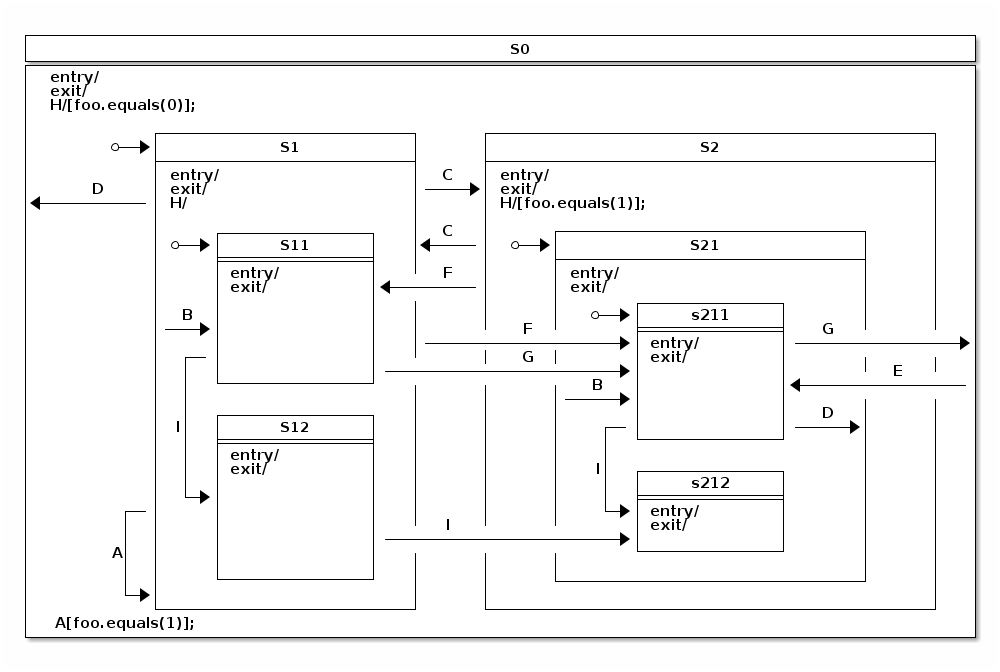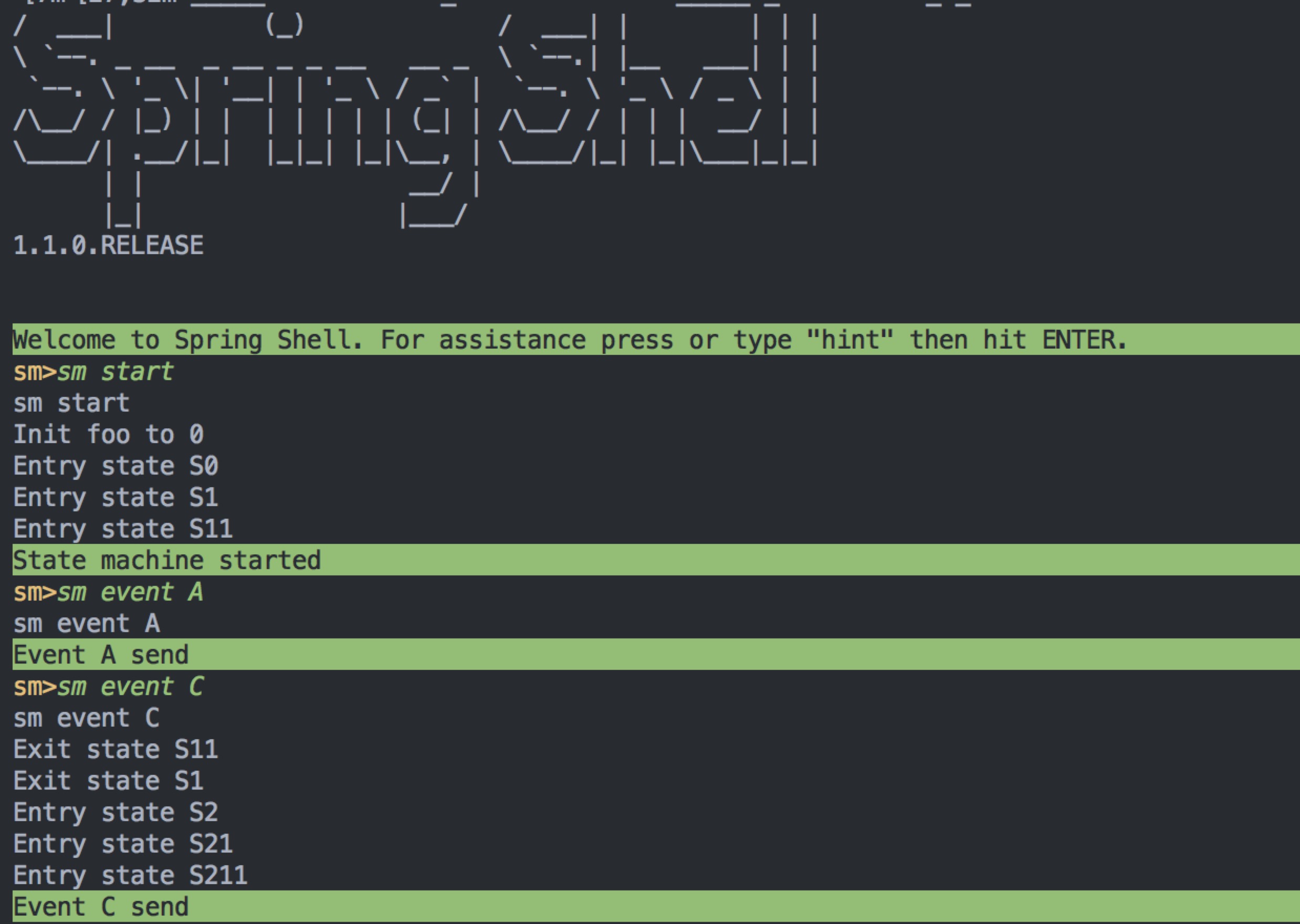Spring Statemachine 更多功能
1 功能介绍
1.1 Hierarchical States
通过 withStates() 和 parent() 定义层次状态
1
2
3
4
5
6
7
8
9
10
11
12
13
14
15
16
17
18
19
@Configuration
@EnableStateMachine
public class Config2 extends EnumStateMachineConfigurerAdapter<States, Events> {
@Override
public void configure(StateMachineStateConfigurer<States, Events> states)
throws Exception {
states
.withStates()
.initial(States.S1)
.state(States.S1)
.and()
.withStates()
.parent(States.S1)
.initial(States.S2)
.state(States.S2);
}
}
为了进一步分析层次状态的功能特性,引用了参考手册Showcase的例子,状态图定义如下

运行官网示例,得到结果如下

根据测试结果得到初步的理解如下:
- 初识状态在每次状态变更后生效,进入S0后会自动进入S1,进而进入S11;
- 当处于子层次(如:S11),事件C发生,因为S11属于S1,满足C条件;
- 代码测试:当前处于子层次(如:S211),事件G发生,会进入S0,然后根据初识状态进入S2(不是S1,与状态机启动时不一致),状态机有历史状态;
- 利用例子测试会出现,一次事件连续两次进入S1的情况(怀疑为Bug),继续跟踪;
- 复杂状态机,需要进行全方位测试,确保状态机中未了解特性影响预期结果。
1.2 Using Actions
Action 是与状态机交互和协作的最有用的组件之一。动作可以在状态机中的各个位置执行,并且可以在状态生命周期中执行,例如进入或退出状态或转换期间。基本配置示例:
1
2
3
4
5
6
7
8
9
10
@Override
public void configure(StateMachineStateConfigurer<States, Events> states)
throws Exception {
states
.withStates()
.initial(States.SI)
.state(States.S1, action1(), action2())
.state(States.S2, action1(), action2())
.state(States.S3, action1(), action3());
}
- action1()在进入States.S1、States.S2和States.S3时生效;
- action2()在离开States.S1和States.S2时生效;
- action3()在离开States.S3时生效;
Action的三种使用
用法1:anonymous function
1
2
3
4
5
6
7
8
9
@Bean
public Action<States, Events> action1() {
return new Action<States, Events>() {
@Override
public void execute(StateContext<States, Events> context) {
}
};
}
用法2:own implementation
1
2
3
4
5
6
7
8
9
10
11
12
@Bean
public BaseAction action2() {
return new BaseAction();
}
public class BaseAction implements Action<States, Events> {
@Override
public void execute(StateContext<States, Events> context) {
}
}
用法3:SpEL expression
1
2
3
4
5
6
7
8
9
10
11
12
13
14
@Bean
public SpelAction action3() {
ExpressionParser parser = new SpelExpressionParser();
return new SpelAction(
parser.parseExpression(
"stateMachine.sendEvent(T(org.springframework.statemachine.docs.Events).E1)"));
}
public class SpelAction extends SpelExpressionAction<States, Events> {
public SpelAction(Expression expression) {
super(expression);
}
}
能够发送事件:Events.E1在action中
1.3 Using Guards
Guard是事件的拦截器,根据Guard的判断结果,决定是否执行后续操作,基本配置如下:
1
2
3
4
5
6
7
8
9
10
11
12
13
14
15
16
17
18
19
@Override
public void configure(StateMachineTransitionConfigurer<States, Events> transitions)
throws Exception {
transitions
.withExternal()
.source(States.SI).target(States.S1)
.event(Events.E1)
.guard(guard1())
.and()
.withExternal()
.source(States.S1).target(States.S2)
.event(Events.E1)
.guard(guard2())
.and()
.withExternal()
.source(States.S2).target(States.S3)
.event(Events.E2)
.guardExpression("extendedState.variables.get('myvar')");
}
同Action,也是三种基本用法
用法1:anonymous function
1
2
3
4
5
6
7
8
9
10
@Bean
public Guard<States, Events> guard1() {
return new Guard<States, Events>() {
@Override
public boolean evaluate(StateContext<States, Events> context) {
return true;
}
};
}
用法2:own implementation
1
2
3
4
5
6
7
8
9
10
11
12
@Bean
public BaseGuard guard2() {
return new BaseGuard();
}
public class BaseGuard implements Guard<States, Events> {
@Override
public boolean evaluate(StateContext<States, Events> context) {
return false;
}
}
用法2:Expression
通过表达式,判断是否为TRUE
1
guardExpression("extendedState.variables.get('myvar')");